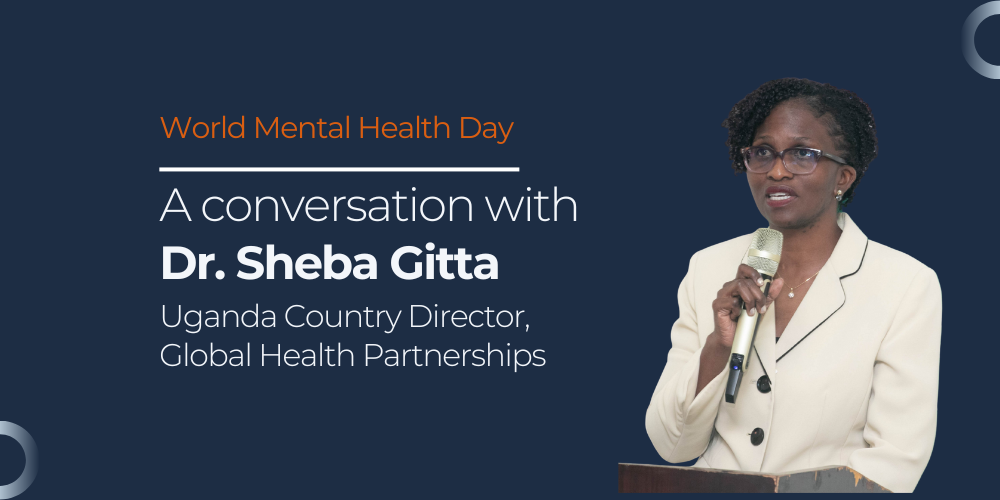Improving Adolescent Mental Health in Uganda: A Conversation with Dr. Sheba Gitta
9 October 2025

This World Mental Health Day we are celebrating our new project to improve adolescent mental health care in Uganda. We spoke with Dr. Sheba Gitta – the Uganda Country Director at Global Health Partnerships (GHP) – about how this project will create lasting change and how partners can join us to bring this vital work to scale.
Dr. Sheba Gitta
1.Why is adolescent mental health such a critical issue to address in Uganda right now?
Uganda has the second youngest population in the world. Over 78% of our population are under 30 years of age and 22 million are children. Like the rest of the world, our young people are increasingly struggling with their mental health, some even turning to suicide. Yet there are only five child psychiatrists in the whole country. With such a young and growing population, the demand for adolescent mental health support is impossible to ignore.
2.Can you tell us about the previous West Uganda Mental Health Project GHP ran in 2022 and the impact it has had on refugee and host communities?
The West Uganda Mental Health Project reached both refugee and host communities. We wanted to tackle the shortage of mental health specialists through training, but also by task-sharing mental health care to frontline doctors and nurses. This meant equipping the health workers in local clinics to also recognise mental illness, provide basic care, and refer severe cases for further treatment. 47 specialists and master trainers and 433 doctors and nurses were trained, helping to bridge the gap in services.
As well as improving the quality of care at health facilities, we also needed to increase awareness of mental health in the community. We established and trained a network of Peer Support Workers, people with lived experience of mental illness who could support others on their recovery journey. They encouraged people to seek treatment, supported them to remain in care, and reduced the number of patients dropping out. Over the course of the project, they carried out 1,050 home visits, 960 hospital visits, and made 214 referrals. Three years later, many are still active, and continue to bring hope to their communities.
3.What is this new project focusing on adolescent health specifically aiming to achieve?
Our new project aims to address adolescent mental health, an area that has been neglected for too long. We are building on lessons from our previous programme and adapting it to meet the needs of young people.
To improve adolescent mental health care at health facilities, doctors and nurses will be trained to recognise mental illness in young people, provide basic care and refer serious cases. We will also strengthen our peer support model, re-engaging those trained before and recruiting new ones aged 18-24 who will better relate to adolescents.
Peer Support Workers will work with teachers to run mental health clubs in schools and raise awareness in communities. They will create safe spaces where young people can speak openly about their mental health without stigma and access help where needed. By linking schools, families, communities and clinics, this project takes a holistic approach. It will help young people not just begin treatment but continue with it until recovery.
4.Schools are a key part of this project. What do you hope to achieve through school-based interventions?
Schools are central to this project because most adolescents spend the majority of their time there. For those in boarding schools, they may only be at home a few weeks a year. Schools already have strong structures, but mental health has rarely been part of them. Few teachers have formal training in mental health, and this is a gap we want to fill. We saw a great opportunity to leverage this and make schools the place where young people can access support.
Children at this age are also more attuned to what they learn from teachers and peers. By changing practices now, we can reshape how they think about mental health in the future.
Through this project, teachers will receive basic training and will be supported by peer support workers to run mental health clubs. These clubs will create safe spaces and reduce stigma. Students who need further help will be referred to trained health workers in clinics, ensuring they receive the right care. In this way, we can help young people to continue their education and thrive.
5.What is your hope for young people in Uganda when it comes to mental health?
My hope is that young people in Uganda grow up knowing that mental health is just like any other health condition. If a child has a fever, they know to tell a parent or teacher and seek help. I want the same to be true for mental health.
I hope this generation of children can learn to speak openly about their struggles, so mental health is no longer stigmatised. I hope they have a clear referral pathway, where issues are picked up quickly and quality care is available at health facilities. I want schools to play their part too, supporting children through treatment so they can recover and continue their education.
Above all, my hope is that no young person feels alone but instead has the care and support they need to thrive.
This World Mental Health Day, we have the chance to change the future for young people in Uganda. With your support, we can break the silence and give adolescents the care they deserve. Join us in making this vision a reality.


1 Comment
Leave a comment
Your email address will not be published.